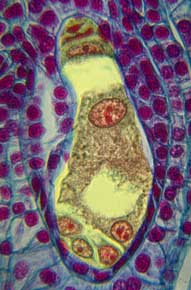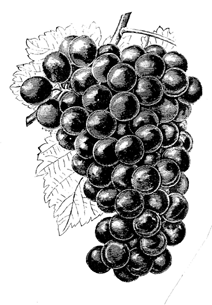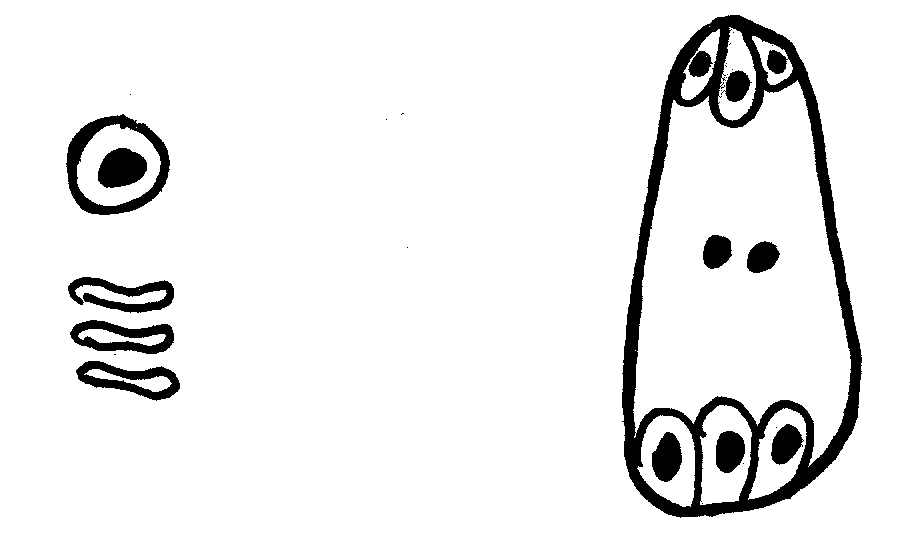| The flowering plants or angiosperms emerged in the Cretaceous period, some 130 million years ago. Their origin Charles Darwin described as "that abominable mystery". These sporophytes dominate the landscape around us and are the most successful plant group, with something like a quarter of a million species described. Angiosperm means "contained seeds" and unlike the previous seed plants examined, the ovules are sealed within the carpel and the seeds sealed within a fruit. |
| People become so obsessed with flowers it is important to remember a flower is nothing
more than a cluster of spore-bearing leaves surrounded by whorls of protective and
often albeit attractive leaves. The flowering plants are classified into 300+ families, largely on the basis of the flower, their reproductive organ. Imagine recognizing an organism on the basis of just its reproductive parts! (see Schiebinger, 1996) |
| The Magnolia flower (right) shows many features of the earliest flowers.
(Soursop flowers are a good local equivalent.) Spirally arranged microsporophylls
(anthers) and megasporophylls (carpels) are surrounded by non-spore-bearing leaves (petals
and sepals which together are termed the perianth). The earliest pollinators were just beetles chomping their way through flowers, accidentally spreading pollen and, in view of the bounty of flower parts, sparing some carpels to form seed and fruit. The insects and flowers co-evolved and flower structure and insect mouth parts have come a long way from these rather haphazard initial relationships. |
| . | New flowering plant features: |
. |
| |
Vessels in the xylem - more rapid water transport than via tracheids as vessels are wider and are stacked one on top of the next forming a continuous pipe |
tracheids vessels |
|
|
Companion cells in the phloem - more
efficient translocation (although in all honesty we really don't understand how the phloem
works!) |
|
| . | . | sieve tube companion cell |
|
Ovule (unfertilized seed)
completely enclosed within the megasporophyll (carpel) with two integuments around the megasporangium (nucellus). Incompatibility mechanisms - |
|
| Female gametophyte greatly reduced
- (yellow region at right) to 8 nuclei. |
 Biodisc photomicrograph |
|
|
|
Unique double fertilization - one male nucleus fuses with the egg to form the zygote which develops into a miniature plant, the embryo. The other male nucleus fuses with two polar nuclei to form a triploid endosperm (orange at right) which develops simply as a food reserve for the developing embryo (red at right). Coconut water is actually a liquid endosperm undergoing free nuclear division to feed
the young embryo in the coconut fruit! |
L.S. Castor oil seed |
|
|
Origin of fruit - development of the megasporophyll (carpel) and often other tissues to form a special structure for dispersal of seeds. The botanist's definition of a fruit often differs from the lay person's. Fruit are not necessarily sweet and juicy. They can be dry and woody. Tomatoes and cucumbers are fruit even if to the average person they are vegetables. |
 |
| . | Sexual reproduction: |
. |
| . | Production of microspores and male gametes | . |
| . | A B C  |
. |
| |
In the pollen sac (microsporangium) of the anther, haploid microspores (A) are formed
by meiosis. Mitosis then follows to produce a two-celled pollen grain (B) with a small
generative cell and a large vegetative cell. This generative cell will undergo further
mitosis to form two male gametes (nuclei). The pollen tube grows though a pore in the
pollen grain, with the tube (vegetative) nucleus at its tip and the male nuclei
behind. |
. |
| . | Production of megaspores and embryosac | . |
| . |
 |
Egg cell surrounded by 2 synergid cells 2 polar nuclei 3 antipodal cells |
| . | functional megaspore
embryosac (other 3 aborted) |
. |
| . | In the nucellus (megasporangium) within the ovary, each megasporocyte undergoes
meiosis to form 4 haploid megaspores, only 1 of which survives. This divides mitotically
to form an 8-celled embryosac. |
. |
| . | Fertilization | . |
| . | Once the pollen grain has germinated, the pollen tube grows down through the style and
enters the embryosac through the micropyle. The pollen tube apparently homes in on the egg
cell based on chemical signals from the synergid cells. The 2 male nuclei are released,
one fusing with the egg to form the zygote and embryo, the other fusing with the 2 polar
nuclei to form the triploid endosperm, a nutritive tissue. A wide range of seed dispersal mechanisms have evolved. |
.. |
| . | In summary: |
| Like all seed plants, the sporophyte is the dominant generation in the flowering plants, varying widely in vegetative structure. | |
| The vascular tissue is more specialized with two innovations - companion cells in the phloem and vessels in the xylem. | |
| The complete enclosure of the ovules by the carpels has lead to the evolution of mechanisms which debar certain types of pollen access to the ovules. | |
| The gametophyte has been internalized (endospory) and reduced to 3 cells in the pollen grain and 8 cells within the ovule. | |
| Double fertilization with both male gametes in the pollen tube functional is unique to the Angiosperms. | |
| The further development of the carpel(s) to produce a structure to aid in dispersal of the seed(s) - the fruit - is also unique to Angiosperms. |
| Would you
like to look at some sample questions on this part of the course? If so, click the button. |
| You have
now been introduced to the Angiosperms. Click the button to look at diversity within this group. |
![]() .
.